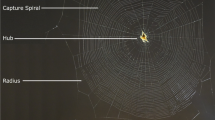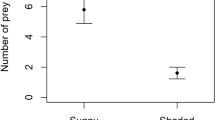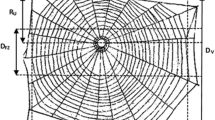Abstract
Cyrtarachne is an orb-weaving spider belonging to the subfamily Cyrtarachninae (Araneidae) which includes triangular-web-building Pasilobus and bolas spiders. The Cyrtarachninae is a group of spiders specialized in catching moths, which is thought to have evolved from ordinary orb-weaving araneids. Although the web-building time of nocturnal spiders is in general related to the time of sunset, anecdotal evidence has suggested variability of web-building time in Cyrtarachne and its closely related genera. This study has examined the effects of temperature, humidity, moonlight intensity, and prey (moths) availability on web-building time of Cyrtarachne bufo, Cyrtarachne akirai, and Cyrtarachne nagasakiensis. Generalized linear mixed model (GLMM) have revealed that humidity, and not prey availability, was the essential variable that explained the daily variability of web-building time. Experiments measuring thread stickiness under different humidities showed that, although the thread of Cyrtarachne was found to have strong stickiness under high humidity, low humidity caused a marked decrease of thread stickiness. By contrast, no obvious change in stickiness was seen in an ordinary orb-weaving spider, Larinia argiopiformis. These findings suggest that Cyrtarachne adjusts its web-building time to favorable conditions of high humidity maintaining strong stickiness, which enables the threads to work efficiently for capturing prey.



Similar content being viewed by others
References
Barlow HS, Woiwod IP (1989) Moth diversity of a tropical forest in peninsular Malaysia. J Trop Ecol 5:37–50
Barton K (2009) MuMIn: multi-model inference. In: R package version 0.12.0. http://r-forge.r-project.org/projects/mumin/
Blackledge TA (2012) Spider silk: a brief review and prospectus on research linking biomechanics and ecology in draglines and orb webs. J Arachnol 40:1–12
Blackledge TA, Kuntner M, Agnarsson I (2011) The form and function of spider orb webs: evolution from silk to ecosystems. A Insect Physiol 41:175–262
Burnham KP, Anderson DR (2002) Model selection and multimodel inference: a practical information-theoretic approach, 2nd edn. Springer, New York
Buskirk R (1975) Coloniality, activity patterns and feeding in a tropical orb-weaving spider. Ecology 56:1314–1328
Cartan CK, Miyashita T (2000) Extraordinary web and silk properties of Cyrtarachne (Araneae, Araneidae): a possible link between orb-webs and bolas. Biol J Linn Soc Lond 71:219–235
Clyne D (1973) Notes of the web of Poecilopachys australasia (Araneida: Argiopidae). Aust Entomol Mag 1:23–29
Craig CL (1987) The ecological and evolutionary interdependence between web architecture and web silk spun by orb web weaving spiders. Biol J Linn Soc Lond 30:135–162
Craig CL (2003) Spider webs and silk tracing evolution from molecules to genes to pehnotypes. Oxford University Press, New York, p 230
Eberhard WG (1977) Aggressive chemical mimicry by a bolas spider. Science 198:1173–1175
Eberhard WG (1980) The natural history and behaviour of the bolas spider Mastophora dizzydeani sp. n. (Araneidae). Psyche 87:143–169
Edmonds DT, Vollrath F (1992) The contribution of atmospheric water vapour to the formation and efficiency of a spider’s capture web. Proc R Soc Lond B 248:145–148
Eisner T, Alsop R, Ettershank G (1964) Adhesiveness of spider silk. Science 146:1058–1061
Harmer AMT, Blackledge TA, Madin JS, Herberstein ME (2011) High-performance spider webs: integrating biomechanics, ecology and behaviour. J Royal Soc Interface 8:457–471
Jackson RR (1977) Web sharing by males and females of dictynid spiders. Bull Br Arachnol Soc 4:109–112
Janzen DH (1988) Ecological characterization of a Costa Rican dry forest caterpillar fauna. Biotropica 20:120–135
Marples BJ, Marples MJ (1971) Notes on the behaviour of spiders in the genus Zygiella. Bull Br Arachnol Soc 2:16–17
Miyashita T, Sakamaki Y, Shinkai A (2001) Evidence against moth attraction by Cyrtarachne, a genus related to bolas spiders. Acta Arachnol 50(1):1–4
Muirhead-Thomson RC (1991) Trap responses of flying insects. Academic, London
Okamoto D (1942) Appearance time on webs in Araneus venticosus. Acta Arachnol 7:133–139 (in Japanese)
Opell BD (1994) Increased stickiness of prey capture threads accompanying web reduction in the spider family Uloboridae. Funct Ecol 8:85–90
Opell BD (1996) Functional similarities of spider webs with diverse architectures. Am Nat 148:630–648
Opell BD (1997) The material cost and stickiness of capture threads and the evolution of orb-weaving spiders. Biol J Linn Soc Lond 62:443–458
Opell BD, Karinshak SE, Sigler MA (2011) Humidity affects the extensibility of an orb-weaving spider’s viscous thread droplets. J Exp Biol 214:2988–2993
R Development Core Team (2013) R: A language and environment for statistical computing. R Foundation for Statistical Computing, Vienna, Austria, Available at http://www.r-project.org
Robinson MH, Robinson B (1975) Evolution beyond the orb web: the web of the araneid spider Pasilobus sp., its structure, operation and construction. Zool J Linn Soc 56:301–314
Sahni V, Balckledge TA, Dhinojwala A (2011a) A review on spider silk adhesion. J Adhesion 87:595–614
Sahni V, Blackledge TA, Dhinojwala A (2011b) Changes in the adhesive properties of spider aggregate glue during the evolution of cobwebs. Sci Rep 1:41
Sandoval CP (1994) Plasticity in web design in the spider Parawixia bistriata: a response to variable prey type. Funct Ecol 8:701–707
Scharff N, Coddington JA (1997) A phylogenetic analysis of the orb-weaving spider family Araneidae (Arachnida, Araneae). Zool J Linn Soc 120:355–434
Selden PA (1989) Orb-web weaving spiders in the early Cretaceous. Nature 340:711–713
Shinkai A, Sadamoto M, Suzuki K, Sinkai E (1985) Notes on the web and the prey of Cyrtarachne. ATYPUS No.86
Stowe MK (1986) Prey specialization in the Araneidae. In: Shear WA (ed) Webs, Behavior, and Evolution. Stanford University Press, California
Stowe MK, Tulmlinson JH, Heath RR (1987) Chemical mimicry: bolas spiders emit components of moth prey species sex pheromones. Science 236:964–967
Suginaga A (1963) Web-building and predation behavior of Cyrtarachne bufo and C. inaequalis. Atypus 31:13–15
Townley MA, Bernstein DT, Gallagher KS, Tillinghast EK (1991) Comparative study of orb web hygroscopicity and adhesive spiral composition in three araneid spiders. J Exp Zool 259:154–165
Vollrath F, Edmonds DT (1989) Modulation of the mechanical properties of spider silk by coating with water. Nature 340:305–307
Vollrath F, Fairbrother WJ, Williams RJP, Tillinghast EK, Bernstein DT, Gallagher KS, Townley MA (1990) Compounds in the droplets of the orb spider's viscid spiral. Nature 345:526–528
Williams CB (1936) The influence of moonlight on the activity of certain nocturnal insects, particularly of the family Noctuidae, as indicated by a light trap. Philos Trans R Soc, B 226:357–389
Yeargan KV (1988) Ecology of a bolas spider, Mastophora hutchinsoni: phenology, hunting tactics, and evidence for aggressive chemical mimicry. Oecologia 74:524–530
Yeargan KV (1994) Biology of bolas spiders. Annu Rev Entomol 39:81–99
Yoshikura M (1987) The biology of spiders. Japan Scientific Societies Press, Tokyo, Japan
Acknowledgments
The Education Committee of Namegawa Town provided comfortable accommodation. The owners of study area, Y. Kami and T. Nagashima, allowed us to use the area, and M. Ishikawa supported us in study area. University of Forest in Chiba permitted us to use its forest and facilities. A. Shimazaki helped us in carrying out this study in Chiba. N. Kato provided us some of the illustrations. J. Pierre and M. Nagendran improved English in early draft. The staffs of the Laboratory of Biodiversity Science of the University of Tokyo offered useful discussion.
Author information
Authors and Affiliations
Corresponding author
Additional information
Communicated by: Sven Thatje
Rights and permissions
About this article
Cite this article
Baba, Y.G., Kusahara, M., Maezono, Y. et al. Adjustment of web-building initiation to high humidity: a constraint by humidity-dependent thread stickiness in the spider Cyrtarachne . Naturwissenschaften 101, 587–593 (2014). https://doi.org/10.1007/s00114-014-1196-9
Received:
Revised:
Accepted:
Published:
Issue Date:
DOI: https://doi.org/10.1007/s00114-014-1196-9




